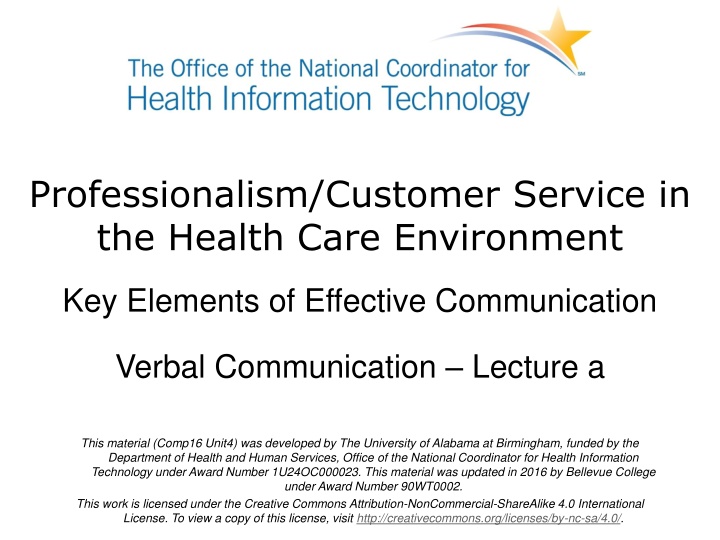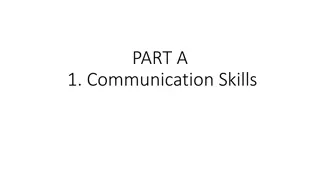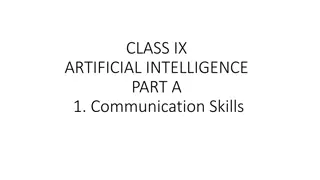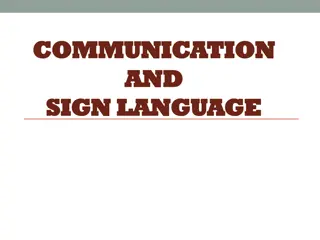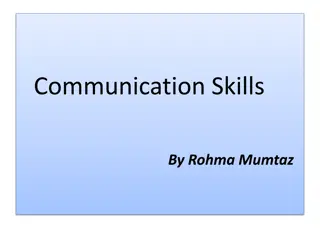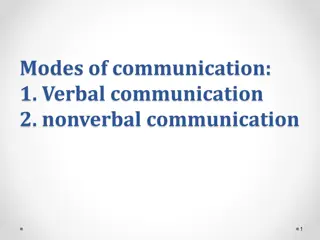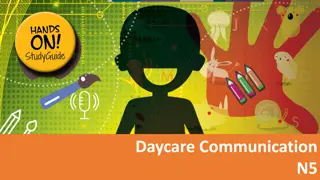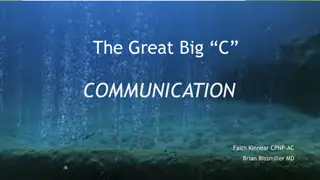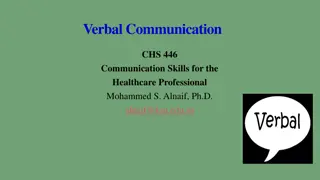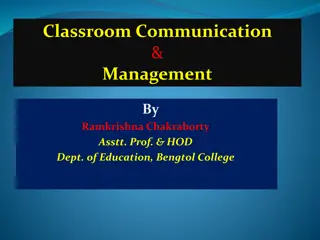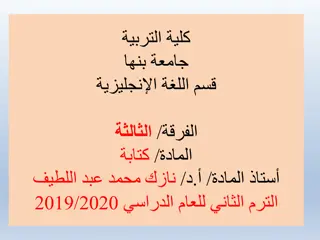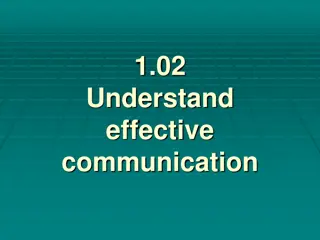Effective Verbal Communication in Healthcare
This material explores the key elements of effective verbal communication in the healthcare environment, covering topics such as defining communication, identifying assumptions, communication models, variables, and the multidimensional nature of communication. It emphasizes the sender-receiver dynamic, information transfer, and the importance of common rules. The illustrations provided enhance understanding of health IT communication.
Download Presentation

Please find below an Image/Link to download the presentation.
The content on the website is provided AS IS for your information and personal use only. It may not be sold, licensed, or shared on other websites without obtaining consent from the author.If you encounter any issues during the download, it is possible that the publisher has removed the file from their server.
You are allowed to download the files provided on this website for personal or commercial use, subject to the condition that they are used lawfully. All files are the property of their respective owners.
The content on the website is provided AS IS for your information and personal use only. It may not be sold, licensed, or shared on other websites without obtaining consent from the author.
E N D
Presentation Transcript
Professionalism/Customer Service in the Health Care Environment Key Elements of Effective Communication Verbal Communication Lecture a This material (Comp16 Unit4) was developed by The University of Alabama at Birmingham, funded by the Department of Health and Human Services, Office of the National Coordinator for Health Information Technology under Award Number 1U24OC000023. This material was updated in 2016 by Bellevue College under Award Number 90WT0002. This work is licensed under the Creative Commons Attribution-NonCommercial-ShareAlike 4.0 International License. To view a copy of this license, visit http://creativecommons.org/licenses/by-nc-sa/4.0/.
Verbal Communication Learning Objectives Define communication. Identify assumptions about communication. Identify general and health-specific communication models. Identify communication variables. 2
Communication Defined Four components: Sender Receiver Transfer of information Common set of rules (e.g., common language) Communication is the process of sharing information using a common set of rules. Northouse & Northouse, 2007 3
Assumptions about Communication Communication is a process. Communication is transactional. Communication is multidimensional. 4
Assumptions about Communication Continued Communication is a process. Communication is transactional. Communication is multidimensional. 5
Assumptions about Communication Continued 2 Communication is a process. Communication is transactional. Communication is multidimensional.
Illustration of Health IT Communication CC BY-NC-SA image by CAST/Joel G Goodman/Marcin Wichary, 2013 7
Assumptions about Communication Continued 3 Communication is a process. Communication is transactional. Communication is multidimensional. 8
Communication Models Shannon-Weaver model Information source Transmitter Sources of noise Receiver Destination Northouse & Northouse, 2007; Shannon & Weaver, 1949 9
Communication Models Continued Shannon-Weaver model Berlo communication model (SMCR) Source Message Channel Receiver Northouse & Northouse, 2007; Berlo, 1960 10
Communication Models Continued 2 Shannon-Weaver model Berlo communication model (SMCR) Source Message Channel Receiver
Common Health-Specific Communication Models The therapeutic model Between clinicians and patients Role of relationships in health The King interaction model Between nurses and patients Relationship, process, transaction Northouse & Northouse, 2007 12
HIT Communication No specific model unique to health IT Communication takes place at many levels Other health IT staff Clinicians Other departments in the organization Communicating change Often requires adapting to the audience 13
Health Care Communications Professional with professional Professional with client Professional with family or significant other Client with family or significant other 14
Communication Variables in Health Care Empathy Control Trust Self-disclosure Confirmation 15
Communication Variables in Health Care Continued Empathy Understanding Improves accuracy of communication Promotes effective interpersonal relationships NOT sympathy or pity Can help disarm users who are stressed by change 16
Communication Variables in Health Care Continued 2 Empathy Control Personal Relational Strive to be collaborative Avoid mandates 17
Communication Variables in Health Care Continued 3 Empathy Control Trust Confidence in others Necessary to create supportive climate Builds client s confidence in your abilities Be prepared to pay the price to earn trust Without trust, success is more difficult 18
Communication Variables in Health Care Continued 4 Empathy Control Trust Self-disclosure Be professional. Use tact in the communication of personal information. Protected health information (PHI) is protected by federal and state privacy regulations. 19
Communication Variables in Health Care Continued 5 Empathy Control Trust Self-disclosure Confirmation Acknowledging others ideas Verbal and nonverbal aspects Ambiguity kills projects: confirmation is an important weapon to vanquish it 20
Key Elements of Effective Communication Summary Lecture a Communication = dynamic, reciprocal process Certain elements contribute to effective communication Empathy Control Trust Confirmation 21
Note on Source Material for This Lecture Much of the material in this presentation has been adapted from the book Health Communication: Strategies for Health Professionals by Northouse and Northouse. 22
Key Elements of Effective Communication References Lecture a References Berlo, D. K. (1960). The process of communication. New York: Holt, Rinehart, & Winston. Broca, P., & Ferreira, M. (2015). Communication process in the nursing team based on the dialogue between Berlo and King. Escola Anna Nery Revista de Enfermagem 19(3), 467 474. Retrieved from http://www.scielo.br/pdf/ean/v19n3/en_1414-8145-ean-19-03-0467.pdf Northouse, L. L., & Northouse P. G. (2007). Health communication: Strategies for health professionals, 4th ed. Stamford, CT: Appleton and Lange. Reussm, G., & Kraft-Todd, G. (2014). EMPATHY: A tool to enhance nonverbal communication between clinicians and their patients. Academy of Medicine 89(8), 1108 1112. Retrieved from http://journals.lww.com/academicmedicine/Fulltext/2014/08000/E_M_P_A_T_H_Y____A_Tool_to_ Enhance_Nonverbal.12.aspx Robbins, S. P., & Judge, T. A. (2017). Organizational behavior, 17th ed. San Francisco: Pearson. Shannon, C. E., & Weaver, W. (1949). The mathematical theory of communication. Urbana: University of Illinois Press. 23
Key Elements of Effective Communication References Lecture a Continued Images Slide 7: HIT Communication by CAST and Joel G Goodman/Marcin Wichary, 2013. Slide 17 : Microsoft clip art; used with permission from Microsoft. 24
Professionalism/Customer Service in the Health Care Environment Key Elements of Effective Communication Lecture a This material was developed by The University of Alabama at Birmingham, funded by the Department of Health and Human Services, Office of the National Coordinator for Health Information Technology under Award Number IU24OC000023. This material was updated in 2016 by Bellevue College under Award Number 90WT0002. 25
